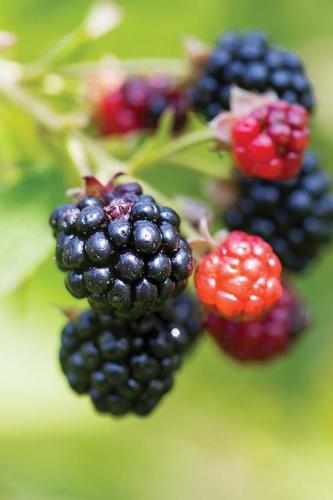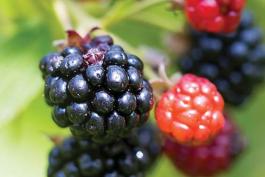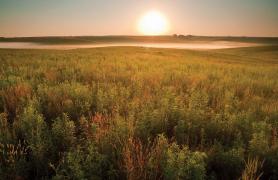Soggy soil got you down? No problem, there’s a plant for that. Are there rocky, bare spots in your Missouri yard? There’s a plant for that, too. No matter the soil type, how rugged the terrain, or how shady your situation, there are Missouri native plants perfectly programmed to bring beauty and wildlife to your home landscape.
Historically, wide expanses of prairie and bright, rocky glades sparkling with drought-tolerant plants made up Missouri’s landscape. Bottomlands near streams flourished with hardwood forests and mosaics of water-tolerant plant life. Then along came farms, towns, industries, and highways. In fact, your own home landscape and its vegetation have probably changed several times.
In spite of these changes, your yard still sits atop its original bedrock, soil, and groundwater systems. It may even harbor some dormant native plant communities, just waiting for the right conditions to bring them back into view.
To choose the native plants that will solve your yard’s toughest landscaping problems, take a look around and decode your property’s trouble spots according to the types of native habitat they exhibit.
Blooming Deserts
Missouri’s landscape is dotted with dry, sunlit areas resembling miniature deserts or informal rock gardens. Thin, rocky soils with tough, textured, and colorful plants characterize areas known as glades. They form atop different types of bedrock such as limestone, dolomite, and sandstone, and each has its own plant community. Glades are home to a wide variety of lizards, butterflies, moths, birds, and other small wildlife.
If your area of concern sits on a south- or west-facing slope in full sunlight and has an outcrop of rocks, you may have the remnants of a glade. Check to see if eastern red cedars, which often invade glades, are growing nearby. The easiest way to begin restoring a natural glade is to cut and remove the cedars. If your thin, rocky area is already open, plant a few swaths of native glade plants to maintain areas of bloom from spring through fall.
Indian paintbrush, Missouri evening primrose, rose verbena, and orange puccoon are spring-bloomers that thrive on rocky terrain. Summer can be brutal on plant life, but black-eyed Susans, yellow coneflowers, and butterfly weed are drought-tolerant plants that add a lot of color without the intensive care that introduced plants require during the heat of summer. An autumn glade is often filled with purple shades of blazing star and fall asters alongside glowing yellow goldenrods.
Establishing a glade in an existing rocky area starts with planting a few potted species and perhaps placing a few more stones to complete the design. Once established, native glade plants self-sow readily without intensive maintenance or watering, and a selection of well-adapted wildflowers, grasses, shrubs, and trees adds color and architecture year-round.
Woodland Neighbors
Many plants are intolerant to shade, but our native woodland species fill a shady niche. Early blooming spring wildflowers can be successfully grown beneath mighty oaks, hickories, and ashes.
Blue phlox, wild geranium, columbine, and bluebells make exceptional showy choices for a shady woodland habitat display. Moist, humus-rich soil with ample leaf litter suits most woodland species in our oak-hickory forests. Once established, they multiply on their own. Since these wildflowers bloom before trees completely leaf out, you can plant a colorful palette that may be accented with understory trees and shrubs such as serviceberry, flowering dogwood, eastern redbud, and pawpaw. Native lowbush blueberries, spicebush, and aromatic sumac also do well along woodland edges.
Cinnamon ferns, Christmas ferns, and maidenhair ferns are natives that add structure and rich earth tones after the wildflowers have finished their early bloom period.
Wetlands and Rain Gardens
Low-lying depressions that remain wet for long periods of time after rainfall are perfect places for plants naturally adapted to growing in damp soils. Eye-catching beauties such as bright red cardinal flowers, blue lobelias, rattlebox loosestrife, and lizard’s tail all make outstanding candidates for such sites.
Areas receiving large amounts of storm water runoff can benefit from an established rain garden. These wide, shallow basins filled with water-loving plants are designed to redirect and slow the flow of storm water and reduce erosion. Plants such as swamp milkweed, southern blue flag, and false dragonhead make ideal selections for these gardens.
For soils with considerable clay content, plants that are tolerant of both wet conditions and dry, compacted soils are your best bet. You can tell if your site has clay if the soil is sticky when wet and forms cracks when it dries out. Purple coneflowers, common milkweed, coreopsis, and purple prairie clover are native wildflowers that take root in heavy soils. Indian grass, bluestem, and buffalo grass also grow well in such sites. Planting clay-tolerant species provides quicker results than trying to amend the soil for plants that are less adapted to such conditions.
Pocket Prairies
A large, sunny, open space away from your house or along a boundary fence may allow you to develop a small-scale prairie devoted to native grasses and wildflowers. With
this type of landscape you replace introduced grasses such as fescue with natives — little bluestem, big bluestem, sideoats grama, and Indian grass.
Among the grasses are hardy wildflowers such as blazing stars, milkweeds, and coneflowers. You may wish to add a few unique looking jewels to the mix. Rattlesnake master and compass plants help to create a more complete prairie atmosphere. Many of these plants also do well along the edges of glades, and they may be used as accent plants.
Digging a Little Deeper
Determining what native plants may do well in your yard sometimes requires a soil analysis. Knowledge about your soil’s pH levels can be beneficial when choosing native plants. Local county extension services can provide information and soil testing. Wildflowers often do not require fertilizer. In fact, many will not grow if the soil is overly enriched. This is especially true of plants that grow on rocky or in heavy clay soils. Some plants fare better in acidic soils. Others thrive under more alkaline conditions.
In the beginning, native plants may require a bit of site preparation such as the loosening of soil or removal of nonnative vegetation to reduce competition with native seedlings. Mowing may also be necessary, especially during the first year. As your native landscape takes hold, you will notice that you have a more self-sufficient site that requires very little maintenance.
Invite Wild Neighbors
Songbirds, butterflies, or other wildlife will come closer to your door if you establish plants that produce berries and seeds. Natives such as blackberries, raspberries, wild plum, coneflowers, milkweeds, and coreopsis provide both food and shelter across the seasons.
Increasing plant diversity translates into wildlife diversity. Over the years a wildlife oasis forms, creating eye-catching appeal.
Be Careful What You Bring Into Your Yard
Some plants may look pretty on the surface, but they can harbor a dark side. Nonnative flowers, shrubs, and trees can create problems for both landowners and wildlife. Escaped exotics such as bush honeysuckles, Bradford pear, and burning bush may naturalize in a new environment and choke out plants that cannot compete with the rapid growth and reproduction of introduced species. Native animals also suffer when aggressive exotics degrade or displace their habitat. Check mdc.mo.gov and search “invasive plants” for a list of plants to avoid planting in your yard.
Native doesn’t always mean appropriate, either. If you have a small lawn, planting fast-spreading natives can get you into trouble with your neighbors if shoots start popping up in their lawn. Native plants that often become aggressive include goldenrod, sawtooth sunflower, and members of the mint family, such as bee balm and wild bergamot.
Before bringing new plants home, be sure to check for local ordinances for special regulations regarding plants and trees, especially those planted under utility lines.
Growing Native Plants is a Win-Win!
Once established, native plants require less maintenance than introduced species, add natural beauty, and provide food and shelter for Missouri’s wildlife.
For advice on native plants and garden tips to fit your property design, check out the Grow Native! program. A partnership of the Missouri Prairie Foundation, the Missouri Department of Conservation, and other organizations, Grow Native! provides valuable information on selecting and growing your own wildlife oasis. Find details on plant specifics such as color, height, and preferred soils, along with local plant nurseries that carry Missouri natives grown from local seed and stock at grownative.org.
In addition, the Missouri Department of Conservation provides many publications on native plants through its website and local offices. The publication Native Plants for Your Landscape at short.mdc.mo.gov/ZoZ highlights designs for butterfly gardens and songbird havens. Nature centers throughout Missouri provide programs designed to showcase Missouri’s plants and animals. For more information or to check on upcoming programs, browse mdc.mo.gov/events or visit your local conservation nature center.






































Also In This Issue

And More...
This Issue's Staff
Art Director - Cliff White
Associate Editor - Bonnie Chasteen
Staff Writer - Heather Feeler
Staff Writer - Kristie Hilgedick
Staff Writer - Joe Jerek
Photographer - Noppadol Paothong
Photographer - David Stonner
Designer - Les Fortenberry
Designer - Marci Porter
Designer - Stephanie Thurber
Circulation - Laura Scheuler






















